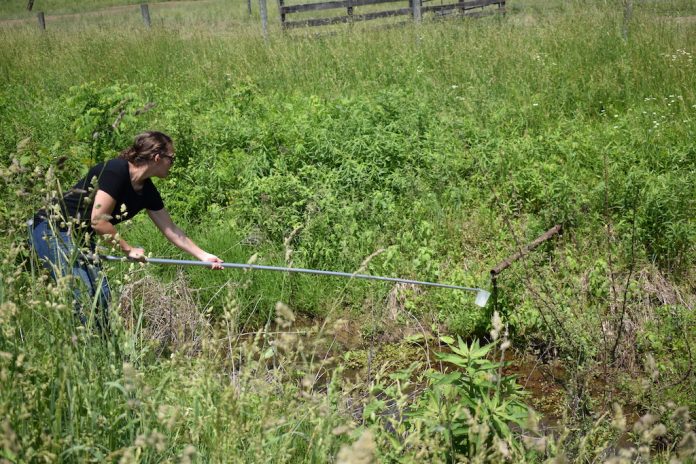
SALEM, Ohio — A few years ago, after hearing about water quality issues in Grand Lake St. Marys and Lake Erie, Van Slack, agriculture specialist for the Muskingum Soil and Water Conservation District, started wondering if farm fields in his county were contributing to nutrient runoff through tile outlets.
He decided to find out. Slack asked for permission to take and analyze tile outlet water samples from farmers in the area. Only one farmer turned him down.
“In most cases, they’ll point out the tile outlets and tell me where there’s more,” Slack said.
Over the years, the district has taken and analyzed samples from more than 30 farms.
Trust
Slack believes the project has worked in part because he has good relationships with many farmers in the county. He noted nutrient runoff is an economic issue for farmers, in addition to an environmental issue.
“You have to have that trust factor,” he said. “We’re not out to get you [farmers] here, we’re trying to figure out what we can do to put more money in your pocket and also do things that are more environmentally friendly.”
The water samples Slack takes go to Lois Zook-Gerdau, a chemistry professor at Muskingum University, in New Concord, Ohio, for analysis.
Zook-Gerdau does not know the farmers involved with the project, since their identities are kept confidential. She does have faith they are invested in conservation.
“I think in general most farmers don’t want to put much fertilizer down if it’s going to be washing down into the watershed,” she said. “They live in the area; they want to have a good environment for their families and farms. I think they get a bad rap, but they’re all trying to do the right thing.”
Analysis
Zook-Gerdau started working with the conservation district in 2005, when the former watershed manager wanted to analyze impairments in the Salt Creek Watershed.
The watershed manager was originally sending samples to an Environmental Protection Agency lab in Columbus. The district did not have the funds to continue sending samples there and turned to the university, where testing could be done at a lower cost.
Zook-Gerdau thought the project sounded interesting, so she agreed to take it on.
Now, instead of looking at watershed water quality, she analyzes agricultural drainage.
“Obviously, the water coming off of the fields ends up in the watershed,” Zook-Gerdau explained.
She tests the water samples for nutrients including nitrogen compounds and phosphate, pH and conductivity.
They have found the phosphate, nitrates and ammonia relatively low in most fields.
Curious about what the water looked like when farmers were not applying fertilizer, Slack took samples from one farm in December 2018. Zook-Gerdau said even in December, these samples had higher levels of nitrate and phosphate compared to some of the other farms.
“The sites that are high tend to be high, and the sites that are low tend to be low,” she said.
Student learning
The collaboration has also created internship opportunities for students at Muskingum University. Students who intern on the project receive a stipend and on-campus summer housing through the Muskie Fellows Program.
Slack works with the intern to draw water samples, which return to the Muskingum lab where Zook-Gerdau and the intern analyze them. Slack said he draws 10-20 samples per week from May to the end of July.
“We can kind of give that student a real-world experience through the district,” Slack said.
In addition to bringing interns to farmers’ fields for sample collecting, the district tries to give interns “a broad agriculture environmental viewpoint,” according to Slack. This can include shadowing other specialists at the district or helping with other district projects throughout the summer.
Mitchel Hoover, a sophomore environmental science major at Muskingum University, was the intern this summer. He had little experience with agriculture before this summer.
“Maybe just a garden in my backyard, but that’s about it,” he said. “It was a huge learning experience for me this summer.”
The internship helped him get another internship for next summer at Murray Energy Company. Hoover said the company showed interest in him as an intern because of his water sampling experience with the SWCD.
Emily Hoffmann, who interned on the project in 2018, said the internship helped her decide what to do with her environmental science major.
“I didn’t expect to enjoy lab work as much as I did, but I also enjoyed working in the field,” Hoffmann said.
She graduated in May 2019 and now works for an environmental consulting firm.
Building relationships
“I think the whole collaboration has really been positive for all the stakeholders involved,” said Zook-Gerdau. “The farmers are getting information about how their fertilizer levels are impacting the water; the Soil and Water Conservation District is getting the ability to run samples … at Muskingum, our students have really learned a lot as a function of this.”









